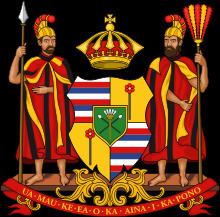Father Keawepoepoe Siblings Kamanawa | Mother Kanoena Nephews Koahou, Naukane | |
 | ||
Spouse KamakaʻeheikuliKealiʻiokahekiliKahikoloa of KauaʻiPuhipuhiʻiliKauhilanahonua Issue KepoʻokalaniUlumāheihei HoapiliHoʻoluluLoe-wahineKekikipaʻa Children Hoapili, Kepookalani, Hoolulu, Kekikipaa Grandchildren Similar | ||
Kameʻeiamoku (died 1802) was a Hawaiian high chief and the Counselor of State to King Kamehameha I. He was called Kamehameha's uncle, but he was really the cousin of Kamehameha's mother, Kekuiapoiwa II.
Contents
Family
Along with his twin brother Kamanawa, Kameʻeiamoku's father was Chief Keawepoepoe. His mother was Kanoena, also Keawepoepoe's sister. Because their parents were siblings, Kameʻeiamoku and Kamanawa were known as nīʻaupiʻo, the offspring of a royal brother and sister.
His grandmother was Princess Kalanikauleleiaiwi of Hawaiʻi, who was also the grandmother of Keōua Nui (Kamehameha's father), making the twins cousins once removed of Kamehameha. Kameʻeiamoku was among the first to support Kamehameha I in his rebellion against his cousin Kīwalaʻō; his fellow supporters were his brother Kamanawa, his half brother Keʻeaumoku Pāpaʻiahiahi, Kamehameha's warrior teacher Kekūhaupiʻo, and Keawe-a-Heulu. These were known as the "five Kona chiefs". Kamehameha took power in the battle of Mokuʻōhai in 1782, which strengthened his influence.
In 1790, the American maritime fur trader Simon Metcalfe of the ship Eleanora mistreated Kameʻeiamoku when he boarded his ship. Metcalfe later fired his cannons on the villagers of Olowalu, killing about one hundred. In retaliation, Kameʻeiamoku attacked the next American ship to appear, the schooner Fair American, under the command of Thomas Humphrey Metcalfe, the son of Simon Metcalfe. All but one of the schooner's crew was killed, including Thomas Humphrey Metcalfe. The lone survivor was Welsh sailor Isaac Davis. Another sailor from the Eleanora, Englishman John Young, was sent ashore to find out what happened, and was also captured. Davis and Young would both become military advisors and translators for Kamehameha.
Kameʻeiamoku participated in negotiating a treaty in February 1795 with George Vancouver for British support of Kamehameha.
Kameʻeiamoku had three or four wives and at least three sons. His first wife, Kamakaʻeheikuli, was the mother of Kepoʻokalani (c. 1760–?) who was the double great-grandfather of the last two monarchs of the Kingdom. His second wife Kealiʻiokahekili was the mother of Ulumāheihei Hoapili (c. 1776–1840). His third wife Kahikoloa was mother of Hoʻolulu (1794–?). Kameʻeiamoku's descendants succeeded him in assisting Kamehameha after his death in 1802 in Lahaina on Maui.
Legacy
Through his son Kepoʻokalani came the House of Kalākaua. One of his other sons Hoʻolulu would be the father of Kinoʻole o Liliha who married the notable American businessman Benjamin Pitman. Daughter Kekikipaa would marry Kamehameha I, but then marry Keawemauhili and become the mother of High Chiefess Kapiʻolani.
He lives on the coat of arms of the Kingdom of Hawaii. On each side of the coat of arms was the figure of a chief in a feather cloak and a feather helmet. The one on the left, bearing a spear, was Kamanawa and the one on the right, with a Kahili (feather standard), was Kameʻeiamoku. The land he was given in 1795 was used by his granddaughter Kuini Liliha, who donated it to Christian missionaries. It eventually became Punahou School in 1841.
